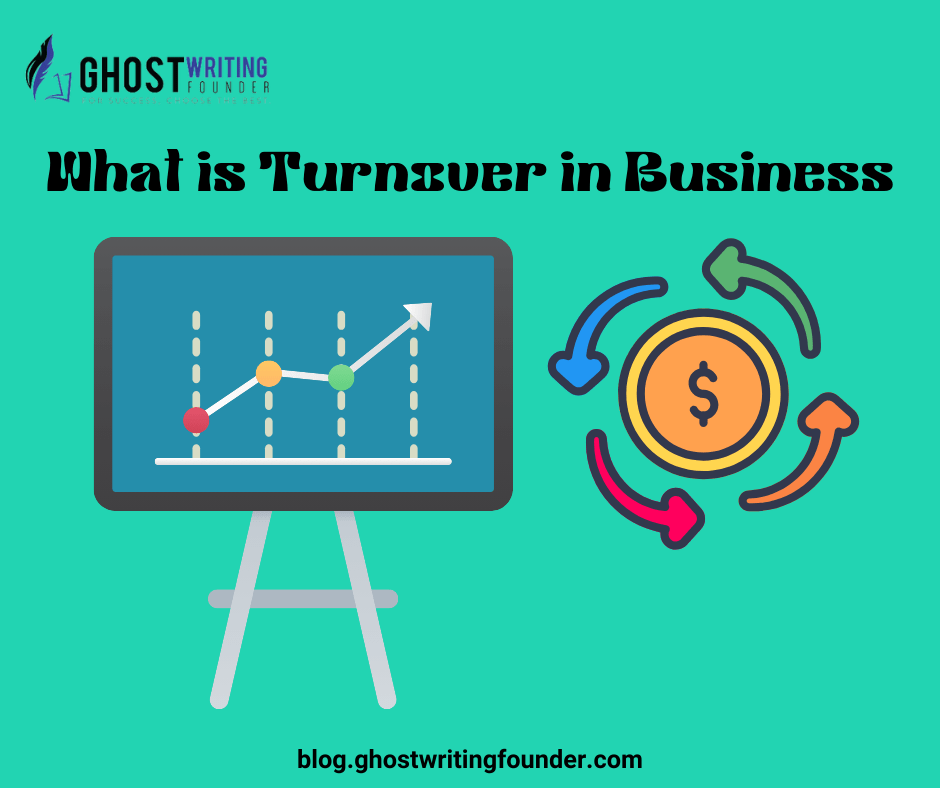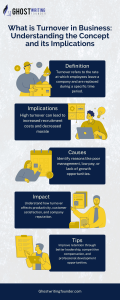
Business Writing
If you’ve ever wondered what ‘turnover business’ means, you’re in the right place. For more insights into business concepts, Ghostwriting Founder will break down the Concept of turnover business into simple terms so anyone can understand it. So whether you are an experienced entrepreneur or not, you will be able to understand the workings of business and how to get started.
What is turnover business?
Turnover business is a word that’s often thrown around in business discussions. But what does it mean?
In the simplest terms, turnover business refers to the number of times something happens within a given period. In the context of business, it usually refers to two main things:
Employee Turnover:
This is about how many employees leave a company and are replaced by new ones within a specific timeframe. Employee turnover can be voluntary (when employees choose to leave) or involuntary (when asked to leave). For a deeper understanding, explore How to Build a Portfolio for Freelancers, as it can provide insights into why professionals might seek new opportunities.
Revenue Turnover:
This is all about the money. Revenue turnover, also known as sales turnover or income turnover, measures how many times a company’s total sales or revenue “turn over” during a specific period. In other words, it tells us how quickly a business makes money.
Understanding Employee Turnover
Let’s dive deeper into the first type of turnover: employee turnover.
Imagine you run a small bakery. Over the past year, you hired and trained 10 new bakers. During the same period, 5 of them decided to leave and find jobs elsewhere. That means your employee turnover rate for the year is 50% because half of your staff turned over.
High employee turnover can be a problem for businesses as It costs money to hire and train new employees, and if they keep leaving, it can disrupt the work and lower morale among the remaining staff. Conversely, low employee turnover can signify a happy and stable workforce.

Calculating Employee Turnover
Calculating employee turnover is pretty simple. Here’s the formula:
Employee Turnover Rate (%) = (Number of Employees Who Left / Average Number of Employees) x 100
In our bakery example, we had 10 employees at the start of the year and 5 left during the year. So, the turnover rate would be:
(5 / 10) x 100 = 50%
That’s how you calculate the employee turnover rate.
The Causes of Employee Turnover
Now, let’s talk about why employees leave their jobs. There can be various reasons:
Better Opportunities:
Sometimes, employees leave for better-paying jobs or jobs that offer more benefits and career growth. For more on career advancement, read How to Become a Novelist.
Unsatisfactory Work Environment:
Employees who don’t feel valued or happy in their workplace are more likely to leave.
Lack of Growth:
Employees may seek opportunities elsewhere if there are no opportunities for advancement or skill development.
Personal Reasons:
Life happens, and sometimes, employees have to leave their jobs due to personal circumstances.
Understanding Revenue Turnover
Now, let’s switch gears and talk about revenue turnover business. This is a crucial concept for businesses of all sizes.
Revenue turnover measures how quickly a business generates income. To understand more about managing business finances, see Mastering Your Money. Let’s break it down:
Imagine you have a lemonade stand. On a hot summer day, you sell 100 cups of lemonade at $1 each. Your total revenue for the day is $100. If you continue to sell at this rate daily for a week, your weekly revenue will be $700 ($100 x 7 days).
So, in this case, your revenue “turned over” 7 times during the week. This tells you how quickly you’re making money.
Calculating Revenue Turnover
To calculate revenue turnover, you can use this formula:
Revenue Turnover Ratio = Net Sales / Average Total Assets
Don’t let the formula scare you off—it’s not as complicated as it looks.
Net sales represent a business’s total money after subtracting any returns, discounts, and allowances. Average total assets are the average value of all the resources (like inventory, equipment, and cash) a business uses to generate income.
Let’s break it down further with a simple example:
Imagine your lemonade stand has $1,000 worth of assets (lemons, cups, a lemonade dispenser, etc.). Over a year, you make $10,000 in net sales. So, your revenue turnover ratio would be:
$10,000 (Net Sales) / $1,000 (Average Total Assets) = 10
This means your revenue “turned over” 10 times during the year.
The Implications of Revenue Turnover
Why is revenue turnover important for businesses? Well, it can have some really big effects that matter a lot.
Working Efficiently:
When a business has a high revenue turnover, they do a great job using their stuff (like equipment and supplies) to make money. Think of it like a super smooth and fast-running machine. This shows that your lemonade stand (or any business) is good at making money with what it has.
Being efficient also means a business doesn’t waste or spend too much money on unnecessary stuff. They use their things wisely, and that’s how they make more money.
Growing Bigger:
People who want to invest in or lend money to businesses often look at revenue turnover. A business with a high turnover rate can look very appealing to these investors. Why? Because it shows that the business can make money quickly and they can use that money to grow and become bigger.
Having More Cash:
A business with a high revenue turnover usually means more money is coming in quickly. For further reading on business growth, check out How to Start a Business with No Money. This is good because it helps with the cash flow. Cash flow is like the money coming in and going out of a business.
Managing Stuff Better:
In some businesses, like stores, how quickly they sell their stuff is connected to how well they handle their things. If a store can sell things fast, they don’t have stuff sitting around for a long time. This is important because things can get old or go out of style.
Main Attributes and Elaborate Information
| Aspect | Description | Key Points |
|---|---|---|
| Employee Turnover | Refers to the rate at which employees leave and are replaced within a company. | – Voluntary or involuntary. – Affects costs, work disruption, and morale. – Calculated using a specific formula. |
| Revenue Turnover | Measures how quickly a company generates income. | – Indicates business efficiency. – Calculated by Net Sales / Average Total Assets. – Impacts investment attractiveness. |
| Calculating Employee Turnover | Formula: (Number of Employees Who Left / Average Number of Employees) x 100 | – Example: 50% turnover rate in the bakery scenario. |
| Causes of Employee Turnover | Reasons why employees might leave their jobs. | – Better opportunities. – Unsatisfactory work environment. – Lack of growth. – Personal reasons. |
| Understanding Revenue Turnover | Importance of how quickly a business generates income. | – Example: Lemonade stand’s daily and weekly revenue analysis. |
| Calculating Revenue Turnover | Formula: Revenue Turnover Ratio = Net Sales / Average Total Assets | – Example: Lemonade stand with $10,000 net sales and $1,000 assets. |
| Implications of Revenue Turnover | Effects of high or low revenue turnover on a business. | – Efficiency in resource use. – Attractiveness to investors. – Cash flow implications. – Inventory management. |
Conclusion
Understanding turnover in business is essential, whether employee or revenue turnover. For more detailed insights, consider our Business Book Editing Services. It’s about how things change and move within your business and can provide valuable insights.
For employee turnover, keeping your staff happy and engaged is crucial to reduce turnover rates. Learn more about creating a positive work environment with SEO Blog Writing Services. This can save you money and create a more positive work environment.
For revenue turnover, it’s a measure of how well your business is using its assets to make money. Enhance your understanding with Content Development Services for effective business strategies. A higher turnover ratio generally indicates a more efficient and potentially successful business. To further enhance your business’s success, explore Website Copywriting for a compelling online presence.
So, the next time someone mentions ” turnover business,” you can confidently join the conversation. You now know to understand what it means and its implications. Whether you’re running a lemonade stand or a large corporation, turnover is a concept that affects us all in the business world.









Leave a Reply